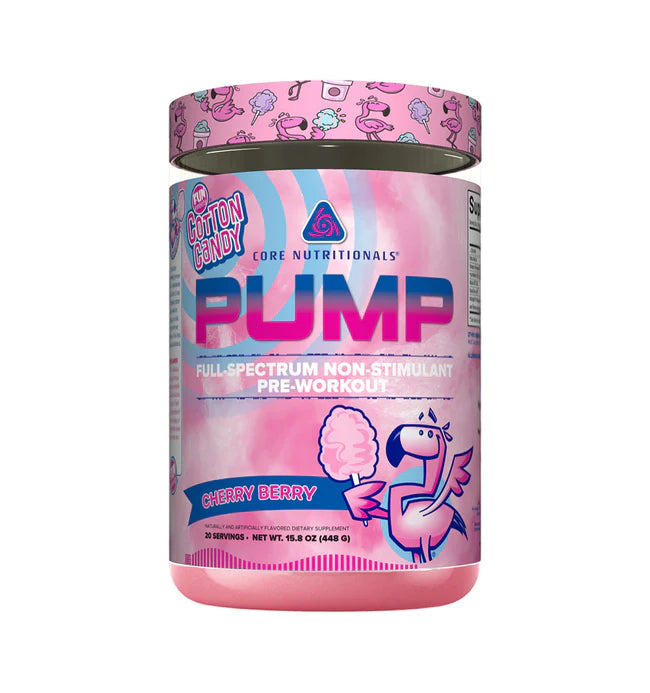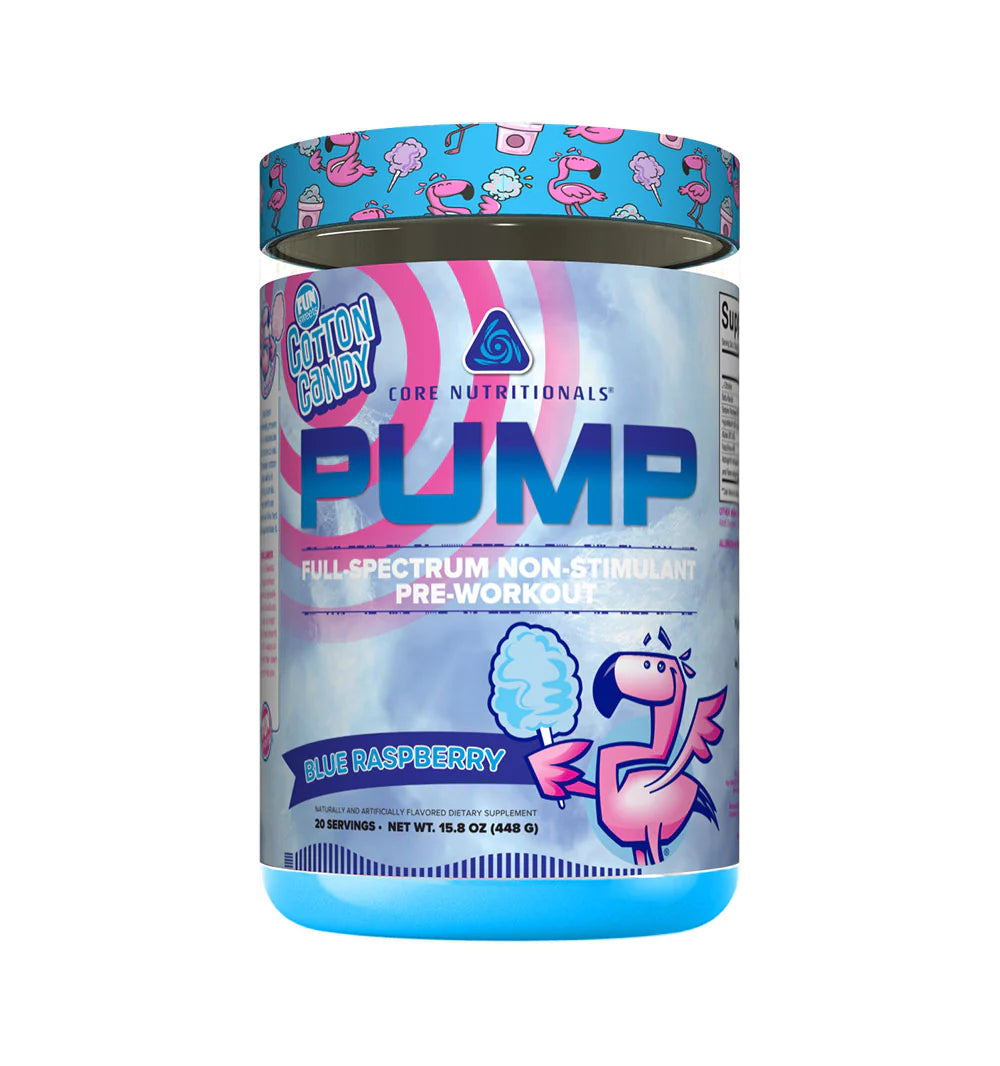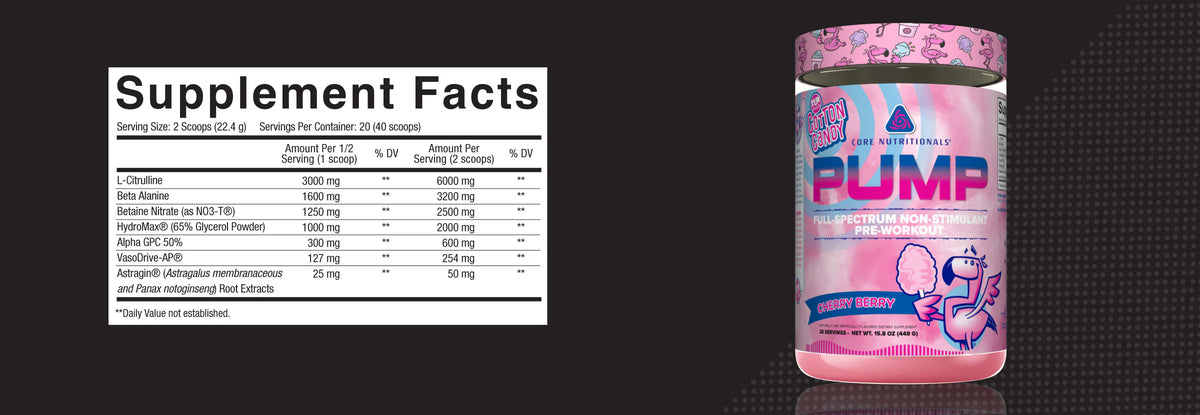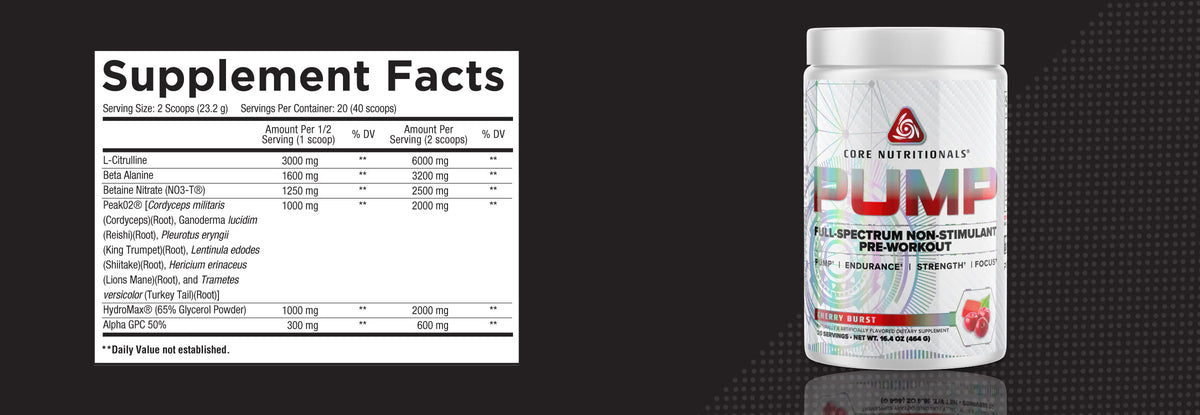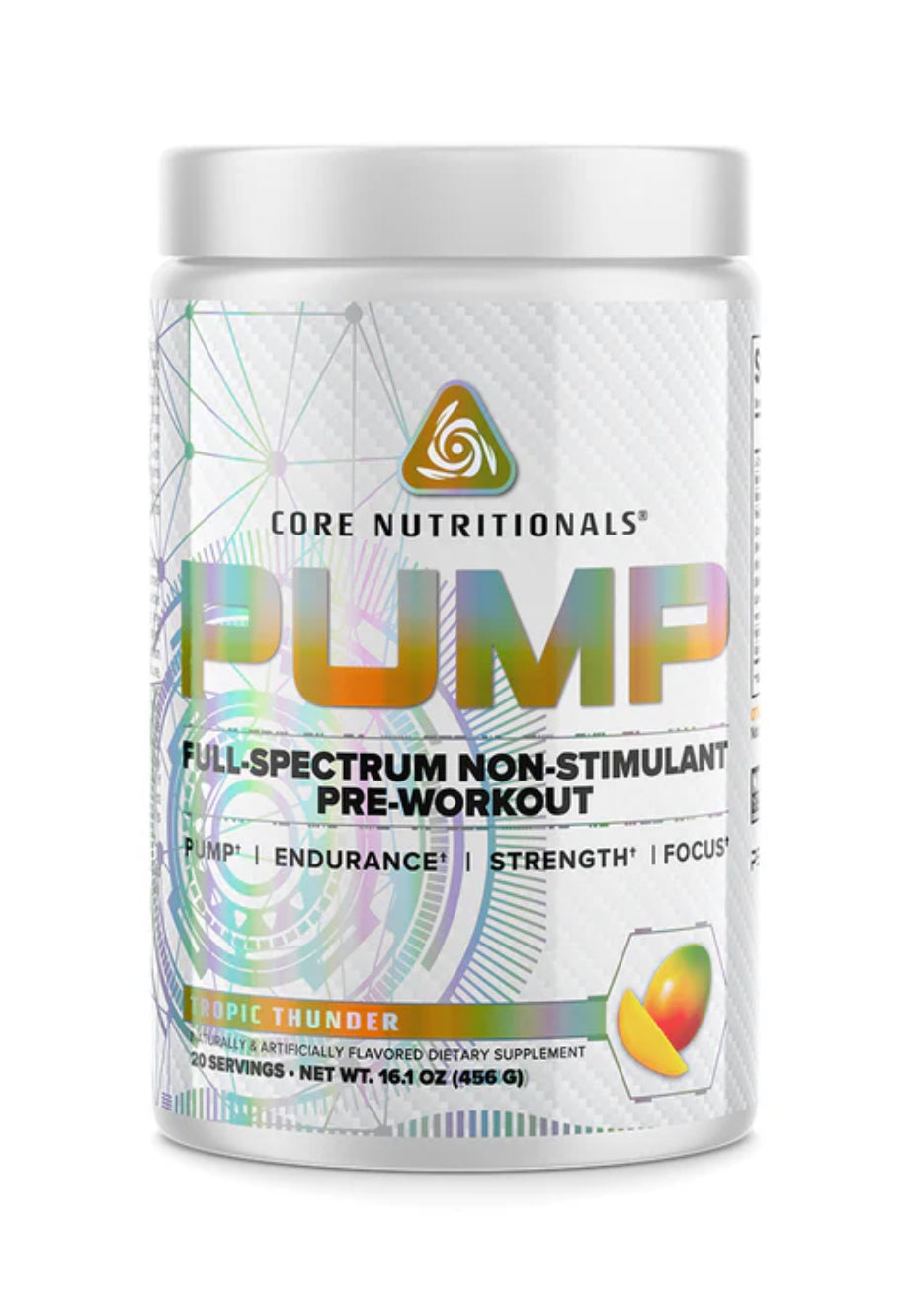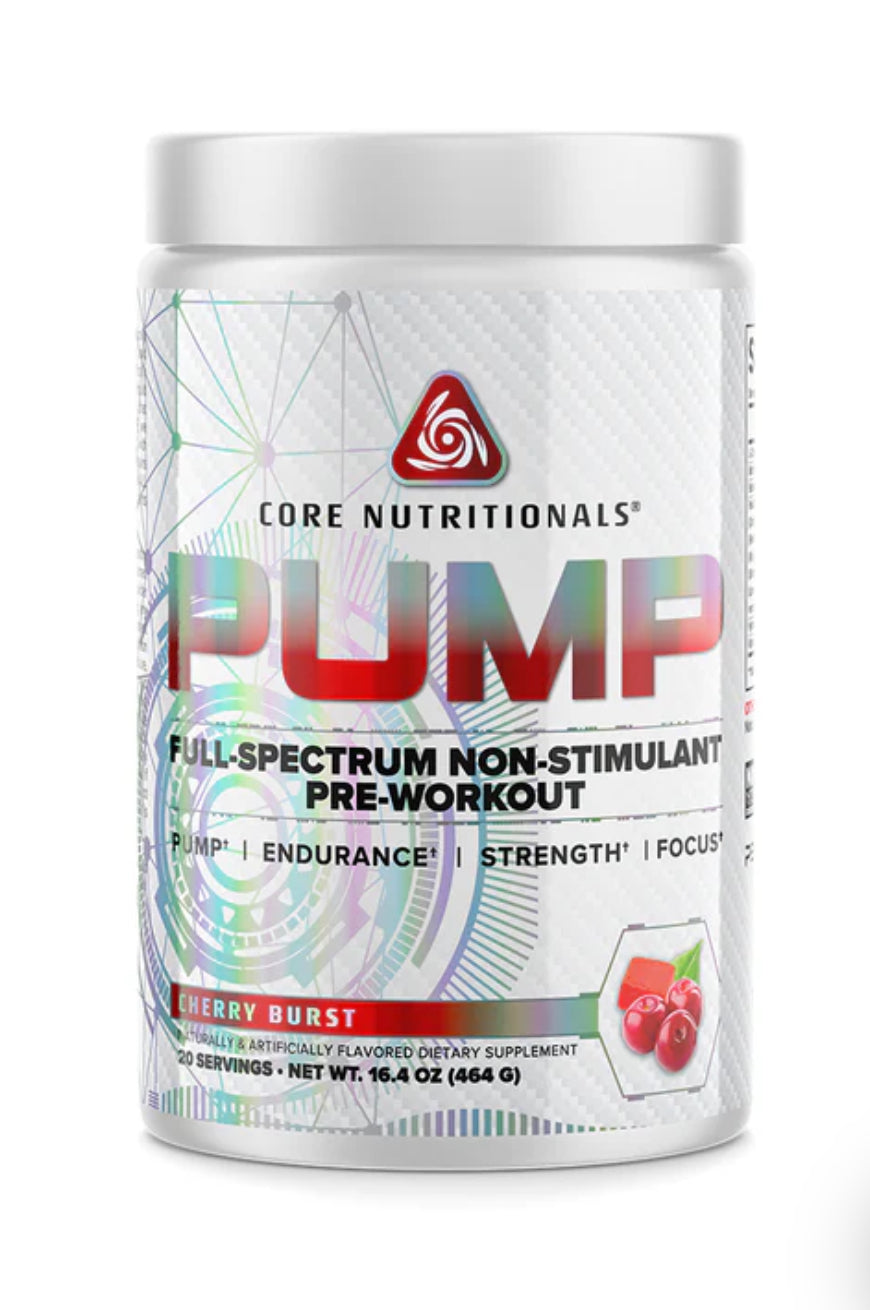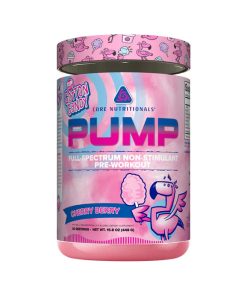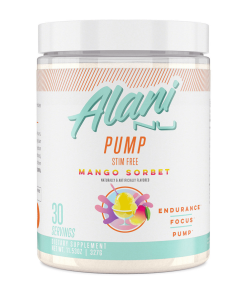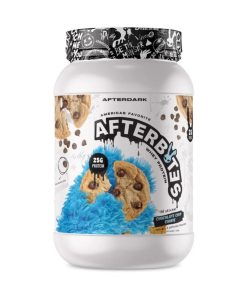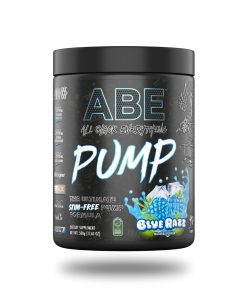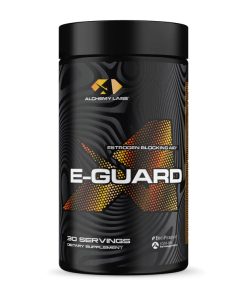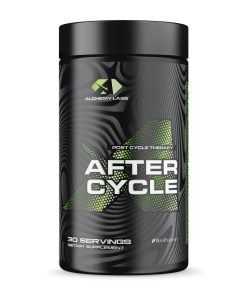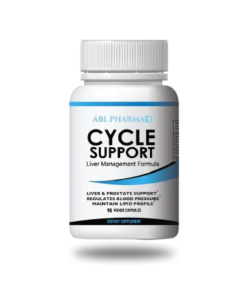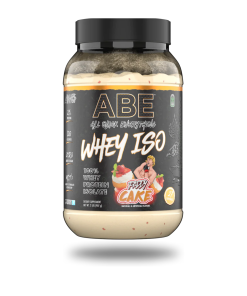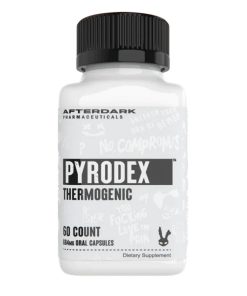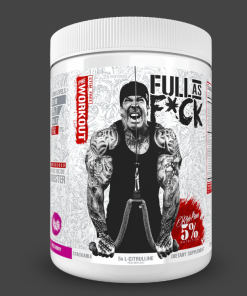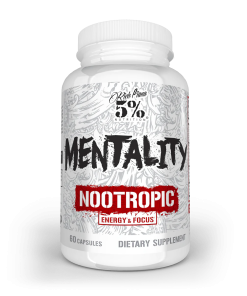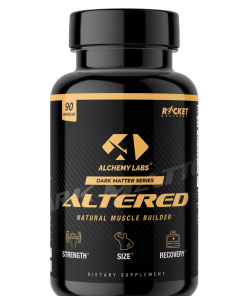It should be simple: the right combination of specifically targeted ingredients for pump, endurance, strength, and focus all blended together to produce a scientifically sound, and complete, non-stimulant pre-workout. It should be, but it isn’t. It is a good thing for consumers, then, that Core Nutritionals loves a challenge. With Core PUMP, we redefine the non-stimulant, pre-workout category with more than just a “pump” product. Core PUMP contains cutting edge and trademarked ingredients to maximize ALL performance aspects of your workout, without stimulants or jitters.†
Non-stimulant pre-workouts typically have a single purpose: increase localized blood flow. That is, deliver a “pump.” The debate surrounding so-called “pump products” is a fair one: are there any physiological benefits to the products? For Core PUMP, this debate is irrelevant – because Core PUMP is not merely a “pump product.” Hence the well-earned tagline, full-spectrum non-stimulant pre-workout.
Physiological Properties and Effects:
L-Citrulline
Citrulline is a non-essential, non-protein amino acid that forms during the urea cycle and forms ornithine when combined with carbon dioxide. Citrulline is also a critical source of endogenous (natural) arginine, as it is rapidly and efficiently converted to arginine in the vascular endothelium and other tissues.
Citrulline’s benefits have been shown to be greater than its parent compound. While arginine undergoes direct hepatic (liver) metabolism through the enzyme arginase, citrulline bypasses hepatic metabolism entirely and it is delivered straight to the bloodstream. The result is that gut absorption and plasma (blood) bioavailability studies comparing citrulline and arginine have shown two things. First, that citrulline is less readily destroyed and has greater absorption than arginine. Second, that citrulline supplementation increases arginine levels more effectively than arginine supplementation itself.
This translates to promising results. For example, animal studies show a significant increase in anaerobic performance at a 250mg/kg/day serving of citrulline, while studies in humans implicate citrulline in both aerobic and anaerobic performance increases. As a critical part of the urea cycle, citrulline’s performance benefits are thought to be a result of its role in ammonia clearance. Citrulline is implicated in reducing the oxygen cost of muscle processes, along with increasing the rate of post-exercise ATP and phosphocreatine replenishment. As ATP and phosphocreatine are the body’s ‘exercise fuel,’ this may result in citrulline delaying time to exhaustion in aerobic and anaerobic exercise.
In combination with the HydroMax™ found in Core PUMP, citrulline’s potential endurance applications are significant.
Beta-Alanine
Carnosine is a bit of an odd duck: we know that it is crucial for muscle function, and that dietary sources of caronsine are essential, but we don’t know precisely how it’s working. Moreover, for decades, we had no idea how to increase intramuscular concentrations, as exogenous carnosine sources degraded in the body so fast as to be effectively useless.
Enter beta-alanine. Simply a different iteration of one of the amino acids that comprises carnosine itself (alanine), beta-alanine has proven to be the most effective means of significantly increasing intramuscular concentrations of carnosine – and therefore of promoting all of carnosine’s various beneficial effects on muscle performance. If that weren’t enough, beta-alanine has also demonstrated beneficial physiological effects independent of its parent compound. In order to understand why, though, we need to first understand some of the basics behind carnosine itself.
Carnosine, a cytoplasmic dipeptide synthesized from the precursors L-histidine and l-alanine, is present in high concentrations in skeletal muscle and plays a pivotal role as a, “chemical buffer” in myocytes (muscle cells). It has long been known that carnosine concentrations are highest in glycolytic, rather than oxidative muscle fibers (roughly speaking, explosive vs., endurance muscle fibers, respectively), and thus long hypothesized that this amino acid is required for sustained performance during supramaximal exercise. Recent research demonstrates that carnosine exerts its physiological effects in long hypoxic (low oxygen) drives by functioning as a high-capacity pH buffer in skeletal muscle, preventing the pH ratio of plasma from dropping too low – and therefore preventing crucial pH-dependent processes such as protein synthesis from being inhibited by acidosis.
Despite its critical role in skeletal muscle anaerobic performance, intramyocellular synthesis of carnosine is rate-limited by the availability of l-alanine. Unfortunately, the majority of literature demonstrates that attempting to increase intramuscular levels of carnosine via either direct carnosine or alanine supplementation is largely ineffective due to carnosine/alanine pharmacokinetics. Enter beta-alanine. Research with beta-alanine demonstrates consistent and dose-dependent increases to intramuscular carnosine concentrations with beta-alanine supplementation, with certain studies showing an increase of 40-60% with chronic administration. These same literature reveal a synergistic effect of exercise on beta-alanine supplementation, whereby the muscle adaptive changes associated with resistance training promote further intramuscular carnosine production in response to beta-alanine supplementation.
In simpler language, this essentially means that beta-alanine is a dietary supplement that promotes its own effects in combination with exercise. As you exercise, you simultaneously intensify beta-alanine’s physiological actions – both directly, as well as in the production of intramuscular carnosine. Once ingested, beta-alanine’s exercise-specific beneficial activity is well-established. Elevation of intramuscular caronsine content via beta-alanine supplementation has been shown to improve performance in the following ways.
- Both acute and chronic increases in total work capacity, measured by total volume during exercise sessions.
- Highly significant increases to TTE (total time to exhaustion), one of the most accurate and comprehensive measures of endurance. In various trials, beta-alanine supplementation has been shown to increase TTE by upwards of 20%.
Increases to total muscle power output in both acute and chronic trials, suggesting that beta-alanine’s most significant benefit is to those engaging in power-dependent resistance training.
In total, a significant body of research exists to suggest that beta-alanine may significantly increase muscle power output, strength, training volume and output, overall performance in hypoxic (oxygen-deprived) conditions and peak VO2 max (oxygen holding capacity).
These myriad benefits make beta-alanine both one of the most-studied, and most well-rounded dietary supplements. Beta-alanine not only has direct, actionable physiological effects, but also promotes critical muscle physiologic adaptations that promote its own effects.
Betaine Nitrate (as N03-T®)
Betaine (trimethylglycine) is found naturally in most living organisms. It is well known to protect non-mammalian animal life in conditions of osmotic stress (a rapid change in the amount of solute surrounding a cell), in addition to functioning as an osmolyte in mammalian (including human) tissues. Betaine is formed in cells as an oxidation product of choline and can be obtained in the diet from foods such as spinach and beets.
Though data on betaine is limited, and recent, the available literature suggests that this compound may have effects in a number of areas. Studies on betaine using servings as little as 1.25g/day and up to 5g/day for up to 14 days have shown promising results. In one study, a 2.5g/day serving was found to enhance endurance and total repetition volume for the squat, bench press, and jump squat in in healthy-exercised trained adults. A similar study using the same serving found that betaine use increased peak power and maximum peak power, along with force and the maintenance of both force and power in healthy, exercise-trained subjects.
Perhaps more interesting, however, is a study which examined betaine’s effect on the endocrine system. This study revealed that betaine may exert an effect on several endocrine processes given the proper conditions, causing the authors to hypothesize that long(er) term betaine supplementation may increase the hypertrophic response to resistance training.
Pairing betaine with the patented nitrate (N03-T®) enhances nitric oxide production via the nitrate-nitrite pathway. Organic nitrate esters have a direct relaxant effect on vascular smooth muscles through non-nitric oxide synthase pathways, being directly converted first to nitrites and then to nitric oxide itself. (With attendant increases to guanylyl cyclase and then cyclic guanosine monophosphate (cGMP), which relax the vasculature.) Pairing both nitric oxide synthase and non-nitric oxide synthase-dependent mechanisms of actions theoretically enhances total NO production, given that rate-limiting enzymatic pathways in either mechanisms do not determine total NO production.
In an absolute sense, both inorganic and organic nitrates also possess benefits beyond a secondary NO-production pathway. Studies in athletes have demonstrated that nitrate ingestion prior to both aerobic and anaerobic exercise meaningfully increases both delay to fatigue and total work capacity – likely a consequence of nitrate’s activation in hypoxic (oxygen-deprived tissues). Nitrate effectively reduces the oxygen cost of muscular activity, making contractions more efficient.
PeakO2®
PeakO2® is an organic-certified combination of six Ayurvedic mushroom strains extracted for their principal bioactives (Cordyceps militaris (Cordyceps), Ganoderma lucidim (Reishi), Pleurotus eryngii (King Trumpet), Lentinula edodes (Shiitake), Hericium erinaceus (Lions Mane), and Trametes versicolor (Turkey Tail).
The results of several human clinical trials on this compound suggest that it may meaningfully and dose-dependently impact several key metrics in exercise performance and physiology. A recent trial on 13 healthy, exercising adults consuming either 1.3 grams of PeakO2 or placebo, for example, demonstrated significant increases to oxygen kinetics, aerobic power and time to fatigue. In the adults receiving the 1.3g of PeakO2 for three weeks, VO2max (a measure of aerobic capacity) increased by 11% as compared to 1.8% in placebo; TTE (total time to exhaustion) increased by 8.2%; and peak power increased by 10%.
The results were similar in an additional study with 40 healthy adults, provided both low and high-dose PeakO2 for 28 days and compared with placebo. In this trial, participants receiving the mushroom extract experienced statistically significant increases to both VO2max and heart-rate economy – suggesting that PeakO2’s effects are both systemic and cumulative. That is, not only does PeakO2 exert its effects on the entirety of the human cardiovascular system – likely due to the multiple mechanisms of action in the mushroom blend – but these effects accumulate over time.
These results suggest that PeakO2 may have beneficial effects on:
- Workout duration
- Time to exhaustion
- Maximum power output
- Peak strength
- Anaerobic peak power
- Oxygen utilization during exercise
- Ability to uptake oxygen
- Exercise capacity
As the mushrooms contained in this compound are also adaptagens, they will also increase the efficacy of the other ingredients in PUMP. Making the addition of PeakO2 both a physiological and economical decision.
Hydromax® (65% glycerol):
Glycerol is a fascinating and highly useful compound that has achieved a somewhat cult status in the fitness community – while both peer-reviewed research and anecdotal reports centered on the endurance functions of glycerol are plentiful, its bodybuilding applications are not as widely lauded. Those who do use glycerol, however, are persistent in their belief that it provides some of the most noticeable, and effective, engorging (“pump”) effects possible.
Glycerol has been well-established as a so-called, “hyperhydrating agent” because of its ability to potently and positively affect plasma (blood) osmolality. As an incredibly powerful osmotic agent, and when combined with large quantities of water, glycerol induces the intracellular retention of fluid (not the extracellular kind, you do not want) that would otherwise be renally excreted. Various research has shown that glycerol’s capacity to positively affect osmolality and expand fluid volume (an increase in total body water) has beneficial effects on performance and physiologic function.
Studies that administered glycerol before both moderate and high endurance fitness tests found that glycerol reduced increases to core temperature, caused athletes to exercise significantly longer before fatigue, reduced urinary elimination of water and increased total body water content, and, in several studies, significantly improved intramuscular water expansion. In less complex terms, this means glycerol has been demonstrated to keep your muscles hydrated, significantly increase the ever-desired, “pump effect” of muscle engorgement, and, maybe most importantly when it comes to a supplement formulation, deliver and keep more nutrients where they are needed (inside the muscle).
Until recently, however, most of these studies noted a significant drawback: the low glycerol concentration of market-available glycerol products forced researchers to test glycerol loads that were significantly higher than average use cases. Core PUMP uses HydroMax® to overcome precisely this problem.
HydroMax® is a highly-concentrated (65%) form of glycerol that offers greater water stability, and therefore potency, as compared to standard GMS (glycerol monostearate). Of particular interest to bodybuilders, HydroMax®’s greater potency translates to even greater levels of intramuscular water retention – keyword, intramuscular, and therefore no bloat – over GMS.
Overall, supplementation with HydroMax® has been shown to:
- Keep athletes hyperhydrated for extended periods of time.
- Reduce post-workout urine volume (more efficient fluid use).
- Lower heart rate and improve endurance time.
- Enhance plasma and intramuscular volume expansion.
Alpha-GPC (Alpha-glycerophosphocholine)
Of the known choline pro-drugs or precursors, Alpha GPC appears to have exert the greatest influence on circulating choline levels. Choline is an essential nutrient involved in numerous metabolic pathways, including DNA regulation and repair, protein function, and metabolism. Perhaps most importantly, the critical neurotransmitter acetylcholine is produced directly from free choline via cholinergic neurons. Acetylcholine is then responsible for several functions itself, most crucially as the compound which induces muscular contraction, and as the neuromodulator partially responsible for modulating risk/reward, arousal, and enhancing memory.
Choline’s essential role as a substrate for acetylcholine, and therefore brain development, is well documented in animal models. These studies demonstrate that levels of free maternal choline have a direct and fundamental impact on prenatal brain development, with the enhancements or deficits lasting into adulthood. Choline’s enhancing effect is particularly prominent in the hippocampus. In humans, the hippocampus is primarily involved in the consolidation of memory (taking short, episodic memory and translating it into long-term memory) and the learning of new information. Acetylcholine is a critical component in these processes, as mentioned above, and choline may therefore play a potential role in these processes as well by providing the substrate for acetylcholine synthesis.
Whether through these, or other independent mechanisms, a recent trial using Alpha GPC demonstrated a statistically significant increase to power output. In a placebo-controlled, double-blind, randomized trial, 14 healthy volunteers, split into an Alpha GPC or placebo group, were tested on various exercises. In comparison to the placebo group, the Alpha GPC group experienced a 14% increase to bench press. The researchers hypothesize that the peak power increase were the result of a substantial acute increase to growth hormone, one of the observed effects of Alpha GPC supplementation.
Core PUMP’s emphasis is what we call a “performance pump” – that is, increasing localized blood flow with a purpose. And the purpose is delivering real, measurable increases to key markers in exercise physiology, such as total time to exhaustion and peak power. We achieve the performance pump in Core PUMP by including ingredients that not only increase dilatory tone – and therefore elicit the “pump” effect – but do so while delivering real performance benefits. Beta Alanine, for example, is well-established to increase endurance, stamina, and peak power output – but it additionally increases blood flow. L-Citrulline is well-established to increase blood flow, but it also increases peak power output. In other words, each ingredient in Core PUMP facilitates the dual purpose behind the performance pump: delivering you the gratifying feeling of a pump, but also servicing your goal of progression.
Beyond its demonstrable performance benefits, PUMP also tastes amazing. We taste tested literally dozens of rounds of PUMP for a flavor matrix that combined amazing taste – which is difficult, if you know the taste of these ingredients! – and a mouth feel that made PUMP eminently drinkable. We think you will agree that we found that combination. Black Lightning, Cherry Burst, and Tropic Thunder are potent enough to deliver the flavor you want, while subtle enough to be sipped and enjoyed – a quality fairly unique to the pump product category, where most products are choked down with a pinched nose.
In sum, the new Core PUMP represents the best non-stim preworkout supplement that Core Nutritionals has to offer: amazing formula with a purpose, combined with great taste.
| Flavor | Cherry Berry, Blue Raspberry, Tropic Thunder, Cherry Burst |
|---|
Prompt Shipping and professional packaging
We offer a broad range of shipping options thanks to our long-standing relationships with UPS, FedEx and DHL. Our warehouse personnel will pack every item to our exacting specifications. Your goods will go through an extensive inspection and will be adequately secured before being shipped. We ship to thousands of customers each day across different countries. The fact that we are committed to becoming the biggest online retailer in the World is obvious. Both Europe as well as the USA have distribution and warehouse centers.
Orders that contain more than one item are assigned processing times in accordance with the item.
Prior to shipment, all purchased products will be thoroughly inspected. Most orders are now shipped within 48 hours. The delivery estimate is 3 to 7 days.
Returns
We don't manage the stock at our factory and warehouse. So the actual stock may fluctuate at any moment. It's possible that the stocks could be depleted after your order has been placed.
Our policy lasts for 30 days. We cannot return or exchange your purchase if it has been 30 days from the date of purchase.
To be considered eligible for return it must be in its original packaging, unopened and in the condition you received it. The item must be in the original packaging.
Related products
Uncategorized
Uncategorized
Uncategorized
Uncategorized
Uncategorized
Uncategorized
Uncategorized
Uncategorized
Uncategorized
Uncategorized
Uncategorized
Uncategorized
Uncategorized
Uncategorized
Uncategorized
Uncategorized
Uncategorized
Uncategorized
Uncategorized
Uncategorized
Uncategorized
Uncategorized
Uncategorized
Uncategorized
Uncategorized
Uncategorized
Uncategorized
Uncategorized
Uncategorized
Uncategorized
